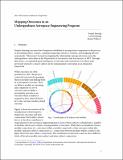| dc.contributor.author | Seering, Joseph | |
| dc.contributor.author | Huang, Luwen | |
| dc.contributor.author | Willcox, Karen E | |
| dc.date.accessioned | 2017-01-27T16:34:43Z | |
| dc.date.available | 2017-01-27T16:34:43Z | |
| dc.date.issued | 2015-06 | |
| dc.identifier.isbn | 978-0-692-50180-1 | |
| dc.identifier.issn | 2153-5965 | |
| dc.identifier.uri | http://hdl.handle.net/1721.1/106654 | |
| dc.description.abstract | Mapping Outcomes in an Undergraduate Aerospace Engineering Program Student learning outcomes are well known to be an important component of developing subject content, communicating expectations to students, and designing effective assessments. This project focuses on mapping the relationships among outcomes across an entire undergraduate aerospace engineering program. In many domains, outcomes are presented simply as lists of capabilities students should gain by the end of a learning activity. This project expands upon the standard presentation by placing all outcomes from the undergraduate program in an interconnected contextual map. To bring further structure to the map, we group outcomes within modules, where we define a module as a learning unit comprised of a set of outcomes.This new outcomes framework provides a structured process for reevaluation and assessment of a curriculum, specifically with regard to intra and interconnectedness of subjects. Several specific motivations drove this project: first, to inspire discussion among faculty about the current and ideal shape of the undergraduate curriculum and potential gaps or overlap among classes; second, to highlight modularity inherent in the curriculum; third, to provide an educational roadmap to students so that they are able to view their progress through the program and self-assess as necessary; and fourth, to provide a framework for dynamic, integrated assessment within subjects.As a part of this project, faculty revised and expanded upon existing outcomes or generated new outcomes. In addition, faculty identified the relationships among outcomes using prerequisite structures and they grouped outcomes in modules. This led to a set of over 700 outcomes for subjects taught within the Aerospace department, over 150 outcomes for prerequisite mathematics and physics subjects taught outside the department, and almost 1000 prerequisite links between outcomes. These outcomes and links, along with their associated subjects and modules, have been entered into a database for which a custom visualization has been developed.The figure on the following page shows connections among outcomes across subjects taught within the aerospace engineering department (showing all subjects that contribute to meeting departmental undergraduate degree requirements).One specific example of how these outcome networks have been utilized is within a junior/senior-level computational methods subject that utilizes a blended learning model. The outcomes map provides an explicit structure that integrates pre-class online readings with in-class active learning activities. Each section of the online readings and the associated embedded assessments are tagged explicitly with the specific outcomes to which they relate. The online platform also provides an integrated linkage of all outcomes across the subject, permitting students to navigate through the online resources to find other lessons and assessment activities that relate to each outcome.The final paper will present the process used to collect and organize the outcomes mapping, the development of the database and visualization tool, conclusions drawn from assessment data collected via student feedback, and specific case studies that demonstrate the utilization of the mapping. | en_US |
| dc.language.iso | en_US | |
| dc.publisher | American Society for Engineering Education | en_US |
| dc.relation.isversionof | https://peer.asee.org/mapping-outcomes-in-an-undergraduate-aerospace-engineering-program | en_US |
| dc.rights | Creative Commons Attribution-Noncommercial-Share Alike | en_US |
| dc.rights.uri | http://creativecommons.org/licenses/by-nc-sa/4.0/ | en_US |
| dc.source | MIT web domain | en_US |
| dc.title | Mapping Outcomes in an Undergraduate Aerospace Engineering Program | en_US |
| dc.type | Article | en_US |
| dc.identifier.citation | Seering, Joseph, Karen Willcox and Luwen Huang. "Mapping Outcomes in an Undergraduate Aerospace Engineering Program" 2015 ASEE Annual Conference & Exposition, 14-17 June, Seattle, Washington. | en_US |
| dc.contributor.department | Massachusetts Institute of Technology. Department of Aeronautics and Astronautics | en_US |
| dc.contributor.mitauthor | Seering, Joseph | |
| dc.contributor.mitauthor | Huang, Luwen | |
| dc.contributor.mitauthor | Willcox, Karen E | |
| dc.relation.journal | Proceedings of the 2015 ASEE Conference and Exposition | en_US |
| dc.eprint.version | Author's final manuscript | en_US |
| dc.type.uri | http://purl.org/eprint/type/ConferencePaper | en_US |
| eprint.status | http://purl.org/eprint/status/NonPeerReviewed | en_US |
| dspace.orderedauthors | Seering, Joseph; Willcox, Karen; Huang, Luwen | en_US |
| dspace.embargo.terms | N | en_US |
| dc.identifier.orcid | https://orcid.org/0000-0003-2156-9338 | |
| mit.license | OPEN_ACCESS_POLICY | en_US |
